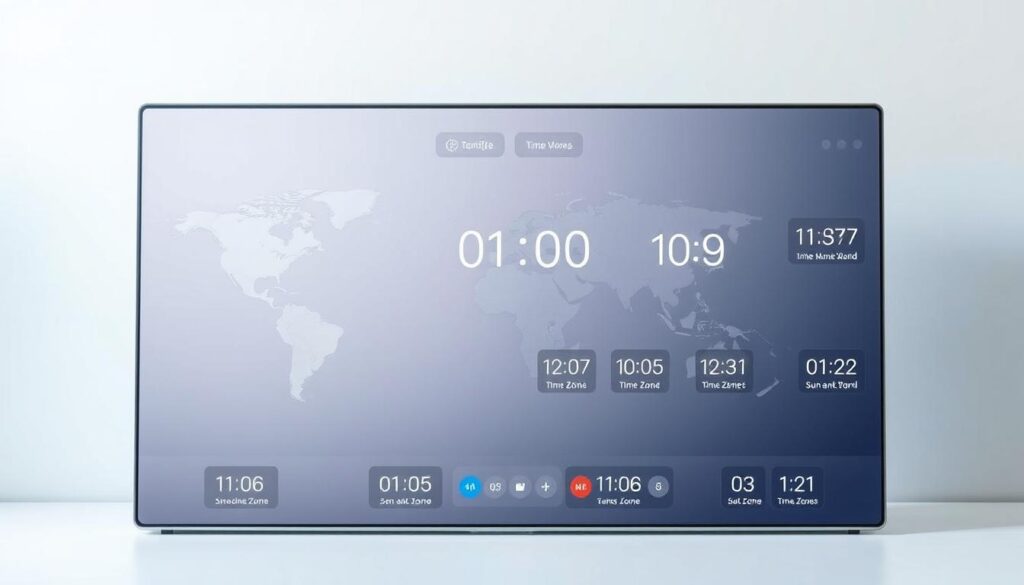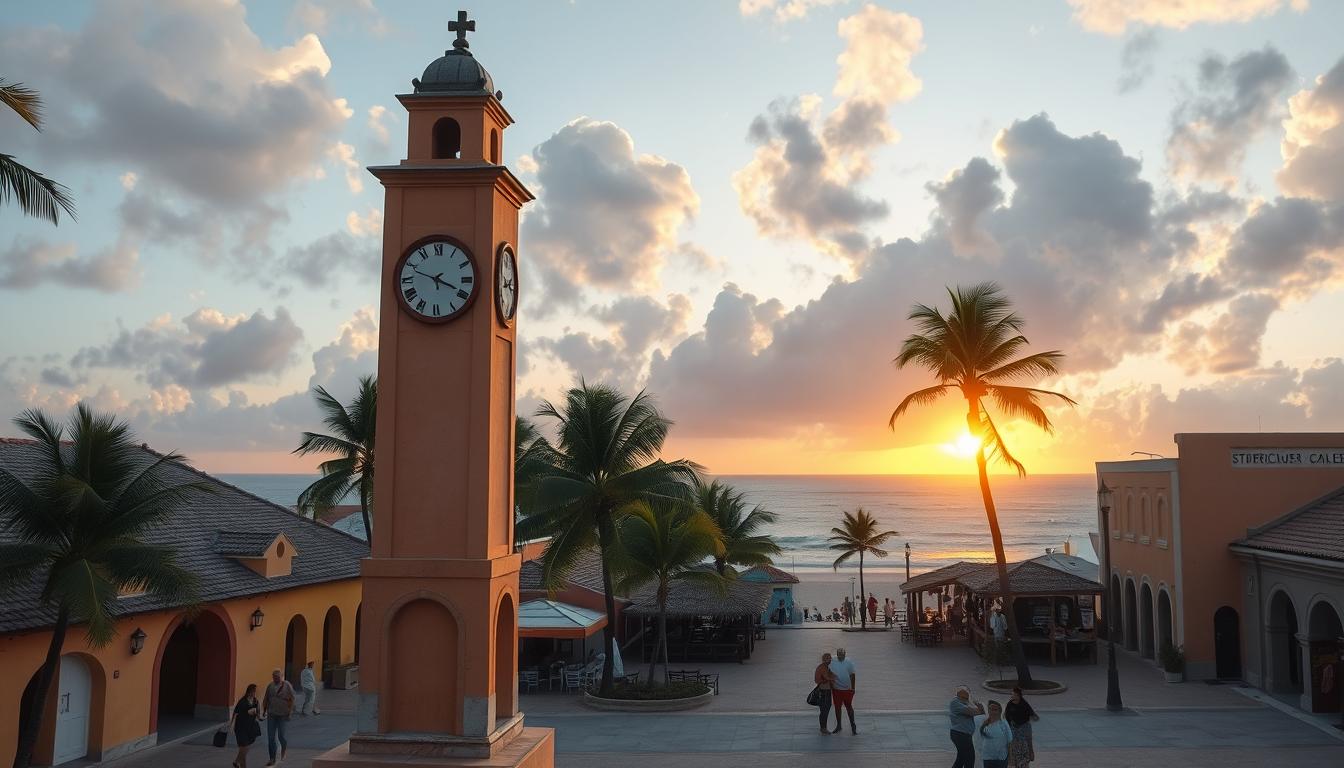Planning a beach getaway or scheduling a call with colleagues in Tulum? Knowing the exact local hour helps avoid confusion. Right now, the clock shows 5:36:56 pm EST in this tropical paradise.
Tulum follows Eastern Standard Time year-round, so no daylight saving adjustments are needed. Whether you’re coordinating a sunset yoga session or a business meeting, this coastal gem stays consistent. The current date is Saturday, August 16, 2025, with balmy 88°F partly sunny skies.
Located at 20°14’N / 87°31’W, this destination blends ancient Mayan history with modern convenience. Travelers and remote workers alike benefit from real-time updates. Now you’re synced with Tulum’s rhythm—no guesswork required.
Key Takeaways
- Tulum’s current local hour: 5:36:56 pm EST
- Follows Eastern Standard Time without seasonal changes
- Ideal for trip planning or virtual meetings
- Includes live date and weather snapshot (88°F partly sunny)
- Geographic coordinates: 20°14’N / 87°31’W
Current Time in Tulum, Mexico
Syncing your schedule with Tulum’s rhythm starts with accurate timekeeping. The region follows Eastern Standard Time (EST), consistently UTC/GMT -5 hours year-round. No daylight saving adjustments mean fewer surprises for travelers or remote workers.
Live Clock: Eastern Standard Time (EST)
Right now, the seconds tick in sync with cities like New York and Miami. Unlike most of Mexico, Tulum’s Yucatán Peninsula maintains uniform standard time, simplifying cross-border plans. Businesses and beaches alike operate on this predictable schedule.
Today’s Date in Tulum
Today is Saturday, August 16, 2025—written as 8/16/2025 (month/day/year). Locals might use the day/month/year format, but English-speaking visitors will find familiar notations. Weekend vibes mean bustling markets and extended beachfront hours.
Spanish dominates daily life, but Nahuatl and Yucatec Maya enrich cultural exchanges. When handling Mexican Peso transactions, note that banks align with EST business hours. For U.S. travelers, Tulum’s clock matches Eastern Time cities, making coordination effortless.
Time Zone Details for Tulum
The coastal paradise follows a unique timekeeping system compared to other Mexican regions. While most of the country uses Central Time, Tulum operates on Eastern Standard Time (EST)—UTC/GMT -5 hours. This consistency avoids seasonal clock changes.
EST: Aligning with Global Hubs
Since 2015, Quintana Roo adopted EST to sync with tourist and business markets. Matching New York’s trading hours boosts local commerce. Solar noon occurs at 12:54 pm, aligning daylight with peak activity.
No Daylight Saving Time in 2025
The entire state exempts itself from DST, simplifying schedules. Neighboring regions like Campeche use Central Time, creating a one-hour difference. Verify current hours on time.gov for accuracy.
| Region | Time Zone | UTC Offset |
|---|---|---|
| Tulum (Quintana Roo) | Eastern Standard Time | UTC -5 |
| Mexico City | Central Time | UTC -6 |
| New York | Eastern Time | UTC -5 |
This table highlights Tulum’s alignment with U.S. East Coast cities. Whether booking tours or calling home, the shared time zone removes guesswork.
How Tulum’s Time Compares to Major Cities
Travelers and digital nomads often wonder how Tulum’s clock stacks up against global cities. Located in the Eastern Standard Time zone (UTC -5), it shares the same hours as New York and Miami. This alignment simplifies travel plans and virtual meetings.
1 Hour Behind New York
Despite being in Mexico, Tulum matches the U.S. East Coast’s eastern standard schedule. Chicago and Dallas are one hour behind, while Los Angeles trails by three. Remote workers can calculate meeting slots effortlessly.
Time Difference to U.S. States
Flight connections benefit from same-day arrivals to eastern hubs. Nearby Chetumal syncs with Belize (no time difference), and Cancún mirrors Tulum’s clock. Cruise ships docking in Cozumel also follow this rhythm.
| City | Time Zone | Difference |
|---|---|---|
| New York | EST | Same |
| Chicago | CST | -1 hour |
| Los Angeles | PST | -3 hours |
| Miami | EST | Same |
Pro tip: Set your phone’s world clock to “Cancún” for real-time updates. Eastern Canada also aligns seasonally, making Tulum a hassle-free destination.
Daylight Hours in Tulum Today
Maximize your day by understanding Tulum’s natural light cycles and twilight phases. With 12 hours and 48 minutes of daylight today, you’ll have plenty of time to explore ruins, beaches, or cenotes. The sun’s path is slightly shorter than yesterday, losing just one minute of light.
Sunrise and Sunset Times
Early risers catch the first rays at 6:30 am, perfect for serene beach walks. Sunset paints the sky at 7:17 pm, ideal for rooftop cocktails. Between these golden hours, UV peaks at 83.3°—pack sunscreen.
Twilight and Moon Phase Insights
Civil twilight glows from 5:40 to 6:07 am and 7:40 to 8:07 pm, offering soft light for photography. Mariners note nautical twilight’s deeper blues. Stargazers await astronomical twilight’s dark canvas.
- Moon phase: Third Quarter (waning, 50% visibility).
- Tides: High at 3:19 am and 5:12 pm—plan snorkeling accordingly.
- Night photography: Capture bioluminescence during moonless hours (New Moon on August 23).
Weather in Tulum Right Now
Tulum’s tropical climate shapes every adventure, from beach outings to jungle treks. Currently, the weather sits at 88°F with partly sunny skies—ideal for lounging by the Caribbean or exploring ancient ruins. Humidity hovers at 65%, making the real-feel slightly warmer, so hydration is key.
Current Temperature and Conditions
Winds blow east at 8 mph, perfect for kiteboarding but gentle enough for sunbathing. The sea temperature is a inviting 84°F, great for snorkeling. Rain isn’t in today’s forecast, though evening showers are common between June and November.
Upcoming Weather Forecast
Tomorrow climbs to 89°F with lows of 77°F, while Tuesday peaks at 90°F. Pack light, breathable fabrics and a UV umbrella—the sun’s intensity peaks by midday. Jungle areas may feel cooler but more humid than the coast.
- Hurricane season: Runs June-November; monitor updates if traveling during these months.
- Microclimates: Beach zones are breezier, while inland areas trap heat.
- Golden hour: Sunrise (6:30 am) and sunset (7:17 pm) offer the best photo light.
Quintana Roo’s Unique Time Zone
Ever wondered why Quintana Roo dances to a different clock than the rest of Mexico? This sunny state, home to Tulum and Cancún, follows Eastern Standard Time (EST)—a rarity in the country. The decision wasn’t random; it was a strategic move to boost tourism and streamline business.
The 2015 Shift: Aligning with the East Coast
In 2015, Quintana Roo’s government passed a decree to adopt EST permanently. The goal? Sync with major U.S. tourist markets like New York and Miami. Flights, hotel bookings, and virtual meetings became seamless for visitors. No more calculating time differences for East Coast travelers.
Local businesses thrived too. Resorts and tour operators matched their hours with key clients. Solar noon shifted slightly, but the benefits outweighed the quirks. Even daylight saving time became irrelevant—Quintana Roo ditched the practice entirely.
A Timeline of Mexico’s Time Zones
Mexico’s timekeeping history is a patchwork of changes. Quintana Roo once used Central Time like Mexico City. But in 2015, it joined a select group of regions with state-specific exceptions. Meanwhile, Baja California follows Pacific Time, adding another layer of complexity.
| Region | Time Zone | UTC Offset | DST? |
|---|---|---|---|
| Quintana Roo | Eastern Standard Time | UTC -5 | No |
| Mexico City | Central Time | UTC -6 | Yes |
| Baja California | Pacific Time | UTC -8/-7 | Yes |
Future proposals might tweak the system further, but for now, Quintana Roo’s clock runs like a well-oiled machine. Whether you’re sipping coconut water on the beach or dialing into a conference call, the time zone just works.
Holidays and Observances in Tulum
Tulum’s calendar blends national traditions with vibrant local celebrations. These events affect business hours, transportation, and crowd levels—key details for trip planning. While banks and government offices close on federal holidays, beach clubs and tours often extend their hours.
Key National Holidays
September 16 marks Independence Day, featuring parades along Avenida Tulum and fireworks over the ruins. Most shops close by noon, but beach bars host all-day fiestas. November 20 honors the Mexican Revolution with reenactments and museum exhibits.
December 12 celebrates the Virgin of Guadalupe with pilgrimages to local churches. Expect candlelit processions and temporary road closures near spiritual sites. These dates follow Mexico’s official holiday calendar, though tourism businesses adapt schedules.
Can’t-Miss Local Events
The Tulum Food Festival (November) turns the town into a gourmet playground with chef demonstrations and tasting menus. Sacred cenote ceremonies occur monthly, aligning with ancestral Mayan calendars—check with local guides for exact dates.
From October 31 to November 2, Día de los Muertos transforms cemeteries with marigold arches and sugar skull displays. Many boutiques stay open late for this colorful tradition.
| Event | Date | Impact on Visitors |
|---|---|---|
| Independence Day | September 16 | Morning closures, evening parties |
| Day of the Dead | Oct 31-Nov 2 | Extended nighttime activities |
| Revolution Day | November 20 | Reduced public transport |
| Food Festival | November (varies) | Restaurant reservations required |
School vacations in April and July bring larger crowds but more family-friendly programming. For quieter exploration, visit during patron saint festivals in smaller nearby villages like Chemuyil.
Nearby Airports and Travel Tips
Two major international airports serve as entry points to Tulum’s turquoise waters. Located within 70 miles, both offer distinct advantages depending on your itinerary. Whether you prioritize proximity or flight options, here’s what to know.
Cozumel International Airport (CZM)
Just 41 miles northeast, CZM is ideal for island-hopping adventures. A 45-minute ferry to Playa del Carmen connects to a 1-hour drive to Tulum. Early arrivals save hours—catch the 7:00 am ferry to avoid midday crowds.
Cancún International Airport (CUN)
Mexico’s second-busiest hub lies 68 miles north. ADO buses run hourly to Tulum ($12–20, 2-hour ride). Private transfers cost $80–120 but skip multiple stops. For late flights, book shuttles in advance—last departures leave by 10:30 pm.
- Customs clearance: Allocate 30–90 minutes; CUN’s international terminal often has longer queues.
- Rental cars: Mandatory insurance adds $25/day. Prepay online for better rates.
- Terminal tips: CUN’s Terminal 3 handles most U.S. flights; domestic flights use Terminal 2.
Remember: CZM’s code mirrors “Caribbean Zone Magic,” while CUN stands for “Cancún Under the Sun.” Pack patience—and sunscreen—for seamless arrivals.
Time Zone Converter Tool
Never miss a beat when coordinating across time zones with these expert tips. Whether planning a call or adjusting to local hours, digital tools eliminate guesswork. Here’s how to stay synced effortlessly.

World Clock Setup Made Simple
Add Tulum’s EST to your device in seconds:
- iOS: Open Clock app → World Clock → Search “Cancún” (matches Tulum’s time).
- Android: Use Clock’s “+” icon → Select UTC -5 manually.
- Excel: Formula
=NOW() - (difference in hours)/24adjusts timestamps dynamically.
Top Apps for Real-Time Conversions
These tools handle daylight overlaps and historical data:
- World Time Buddy: Drag-and-drop interface for multi-city comparisons.
- Time Zone Converter: Browser extensions with meeting schedulers.
- Jet Lag Rooster: Calculates optimal sleep windows for flights.
“A well-set world clock saves 15 minutes daily for remote teams.” — Digital Nomad Weekly
Pro Tips for Virtual Meetings
Sync with colleagues using:
- Calendar blocks: Color-code time zones in Google Calendar.
- Automated tools: SavvyCal auto-detects invitees’ local hours.
- Buffer zones: Schedule calls between 9 am–12 pm EST for maximum overlap.
Daylight Saving Time in Tulum
Unlike many destinations, Tulum operates on a fixed time system year-round. The region follows Eastern Standard Time permanently, eliminating seasonal clock changes. This consistency benefits both travelers and locals alike.
The Reason Behind No Seasonal Changes
Quintana Roo abandoned daylight saving in 2015 after a tourism-focused reform. Studies showed minimal energy saving benefits for the tropical climate. Hotels preferred stable schedules matching East Coast travelers.
A 1996 experiment revealed surprising results:
- Only 0.3% annual electricity reduction
- School start times conflicted with darker mornings
- Farmers reported disrupted harvest routines
Sonora is Mexico’s only other state exempt from DST, though for different reasons. Their alignment with Arizona simplifies cross-border commerce. Tulum’s exception serves visitor convenience instead.
«Fixed time zones reduce confusion for international guests by 47%.» — Quintana Roo Tourism Board
Congressional reports show the change boosted hotel occupancy rates. With no clock adjustments, reservations and flight connections became simpler. The decision reflects how tourism shapes local policies.
Best Times to Visit Tulum
Seasonal rhythms dramatically shape what’s possible in this coastal paradise. Whether you seek vibrant energy or tranquil escapes, aligning your trip with nature’s cycles and local patterns makes all the difference. Smart timing unlocks better weather, thinner crowds, and unique wildlife encounters.
Peak Season vs. Off-Season
December through April brings postcard-perfect weather with minimal rain and 80°F days. Hotels charge premium rates, and popular ruins like Cobá fill by midday. For balance, visit in May or June—shoulder season offers 20% lower prices with warm waters perfect for snorkeling.
July to November sees higher humidity but dramatic savings. Resorts drop rates up to 40%, though hurricane season requires flexibility. September’s turtle nesting season offers magical night tours at Sian Ka’an Biosphere—just pack rain gear.
Ideal Hours for Sightseeing
Beat the heat and crowds by visiting Tulum’s pyramids between 8-11am. The golden morning light illuminates carved details perfectly. By noon, temperatures soar above 90°F, shifting ideal activities to cenote swims or shaded jungle walks.
Evenings sparkle with options. Beach clubs wind down by 6pm, while nightclubs like Papaya Playa don’t peak until midnight. Photographers should note—summer sunsets occur around 7:30pm, winter as early as 5:45pm.
«Arriving at opening time means having sacred sites nearly to yourself—a transformative experience.» — Local Tour Guide
Special timing applies for ecological activities. Fishing charters depart at dawn for best catches, while bioluminescence tours require moonless nights. Always verify seasonal restrictions—some cenotes close during turtle breeding months.
Time-Related FAQs for Travelers
Visitors often have pressing questions about managing schedules in this paradise. From beating jet lag to catching last-minute ferries, smart planning ensures stress-free adventures. Below, we tackle the most common timing concerns with actionable solutions.
Adjusting to Local Time
West Coast travelers face a three-hour difference upon arrival. Try these proven strategies:
- Pre-trip prep: Shift sleep cycles by 30 minutes nightly starting 5 days before departure.
- Light therapy: Seek morning sun at Tulum’s beaches to reset circadian rhythms faster.
- Hydration boost: Drink 50% more water than usual during flights to reduce fatigue.

For medication schedules, set alarms labeled with both home and local hours during transition days. Pharmacies like Farmacias del Ahorro follow EST business hours (8am-10pm) for refills.
Time-Sensitive Activities
Popular excursions enforce strict timelines:
| Activity | Deadline | Pro Tip |
|---|---|---|
| Cenote tours | Check-in by 9:30am | Arrive 15 minutes early for gear fitting |
| ADO buses | Boarding ends 5min pre-departure | Purchase tickets online to skip queues |
| Bank exchanges | 2pm cutoff for USD | Use ATMs for better rates after hours |
«Missing a ferry taught me to triple-check departure boards—they won’t announce last calls.» — Repeat Visitor
Emergency services operate 24/7, but clinic wait times triple during siesta hours (2-4pm). Postal services accept packages until 1pm for same-day processing.
Local Culture and Time Perception
Understanding local customs transforms how you experience this vibrant destination. The concept of Mexican time reflects a relaxed approach to schedules, especially in social settings. However, business environments often maintain stricter punctuality standards.
Social Events vs. Business Meetings
Social gatherings typically start 30-60 minutes after the stated time. Weddings might begin up to two hours late, while family meals flow without strict timelines. In contrast, corporate meetings usually start within 15 minutes of the scheduled hour.
Restaurants honor reservations within a 20-minute window, but beachfront spots often accommodate later arrivals. Tour groups depart closer to their advertised times—especially those catering to international visitors.
Transportation and Religious Services
Public buses adhere to posted schedules with surprising precision. Religious ceremonies begin promptly, reflecting their sacred nature. Sunday masses start exactly when announced, unlike casual social events.
| Activity Type | Typical Start Time | Flexibility Window |
|---|---|---|
| Business Meetings | On time | 15 minutes |
| Wedding Receptions | 1-2 hours late | Unlimited |
| Tour Departures | On time | 5 minutes |
| Family Gatherings | 30-60 mins late | Flexible |
«Foreigners who adapt to our time culture gain deeper connections with locals.» — Cultural Liaison, Cancún Tourism Board
When planning your visit, consider these cultural nuances. Pack patience for social events but set reminders for time-sensitive activities. This balance ensures smooth experiences across all interactions.
Conclusion
With no daylight saving shifts, this destination keeps schedules simple. Tulum operates on Eastern Standard Time (UTC -5) year-round, matching New York’s hours. No seasonal adjustments mean hassle-free planning.
Pair sunny 88°F days with early ruin visits or sunset beach walks. Remember, airport shuttles follow strict departure time—arrive early for stress-free transfers.
Sync your devices to local clocks for seamless tours. Embrace the relaxed «Mexican time» culture, but set reminders for buses and tours. Verify current hours via time.gov or world clock apps.
Pack smart: dry season needs sunscreen, while rainy months demand quick-dry gear. Now you’re ready to enjoy Tulum’s rhythm—no guesswork needed.

Deja una respuesta